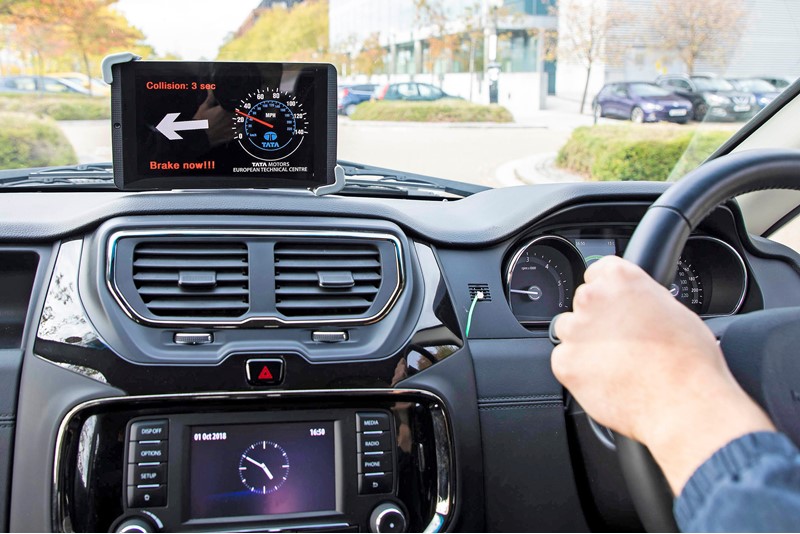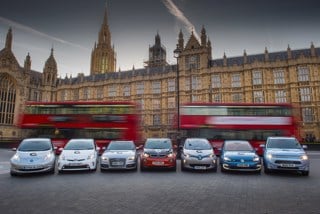This editorial feature appears in the July 25, 2019 issue of Fleet News and is sponsored by AA and Goodyear
The size of the UK’s company car parc has remained stable at just less than one million since the turn of this decade, although the latest Government figures provisionally indicate a reduction in number in 2017/18.
Many industry experts predict this will shrink further as factors such as rising taxes, increasing urbanisation and new, alternative mobility solutions have an impact.
However, recent research indicates there is plenty of life left in the sector.
The British Business and Mobility Study, produced by Sewells Research & Insight, found that two-thirds (66%) of businesses expect their essential use car numbers to stay the same over the next five years, while 18% forecast an increase and 16% a decrease.
Similar findings emerge from research into perk car forecasts, although more businesses expect to see the number of cars decrease (25%) than increase (18%). The rest see the size of their perk fleet remaining consistent.
Read the sponsor's comment by David Morris, channel manager, Goodyear Dunlop Tyres UK.


A survey of business decision-makers by Europcar Mobility Group UK found 45% of respondents saw company cars or vans as part of the mobility landscape in 2022 – the highest proportion of any available option – while Alphabet’s What Moves Britain? report found almost three-quarters (73%) of British workers believe their vehicle is essential for their daily commute.
“For a lot of people, the car is still their tool to have the freedom of choice to go wherever they want and to remove that or change it is a difficult thing to do,” says Uwe Hildinger, COO at Alphabet.
In corporate circles, there is a lot of discussion about mobility solutions and research by Arval Mobility Observatory shows interest is high, says its head Shaun Sadlier.
Nevertheless, in urban environments, new policies are emerging that will put pressure on car use, as better air quality, reducing congestion and improving safety take priority.
However, Sadlier adds: “While decision-makers and employees in organisations are interested in mobility solutions, it appears the vast majority see them as supplementing or being a partial alternative to the traditional fleet.
“We believe the reasons for this are simple: employees value having the company car and the benefits it brings.
“The other is that, when a typical multi-stop journey is undertaken, a car is literally the only practical option.
“A mixed provision model is one that we have been saying for some time is the most likely to develop in the majority of businesses, where a range of mobility solutions are used alongside company cars with employees using the most appropriate form of transport for each journey.”
Organisations and drivers would be unwise to dismiss the “fantastic benefit” of a company car, according to Mike Moore, director at Deloitte LLP.
“There are lots of emotive things that make employees feel valued about the type of car provided to them,” Moore says.
“It certainly ticks the box on duty of care if you require your employees to drive on business. It’s important that you are providing them with something that is safe and well-maintained, and a company car ticks that box.
“There is also your corporate responsibility on a wider level which includes duty of care, but when you get into the retail market, the incentives for choosing greener cars are not as great as they are in the corporate market.”
This is supported by British Vehicle Rental and Leasing Association (BVRLA) research which found grey fleet cars are typically older and more polluting than company cars: the average age of a grey fleet vehicle is 8.1 years (leased company car 2.1 years) and emits 21% more CO2 at 138g/km than the average company car.
Change factor 1: Fuel type
The Government’s announcement that drivers of fully electric cars will pay no company car tax in 2020/21 has provided a huge boost to the likely uptake of electric vehicles (EVs) by fleet drivers.
“Provided planned manufacturer model releases of electric cars are backed up by the ability to deliver in volume, and the Government continues to utilise fiscal policy to incentivise the cleanest vehicles, we expect to see the number of electric cars grow on fleets,” says Claire Evans, head of fleet consultancy at Zenith.
“Growth is likely to be the greatest in the lower mileage and perk population to start with, and we’d expect a reversal of the trend towards perk drivers taking the cash as they realise the financial benefits of low company car tax when moving into electric for their next vehicle.”
Evans says that with the consolidation of the still-immature charge points market and rapid development of technology, fleet managers should look at who can offer them the best solution for their business.
This includes thinking more broadly to consider benefits from maximising efficiencies through combining electric and charge points procurement to take advantage of options to plough unused energy back to the grid.
She adds: “To prepare for this shift in adopting new, cleaner technologies, fleet managers should begin to design their driver policies now with eligibility criteria, charging infrastructure and employee responsibilities in mind.
“In addition, fleet managers should set up policies to enable an easy assessment of whether an electric equivalent will be more cost-effective than an ICE (internal combustion engine) car – understanding daily travel needs will be key.”
Organisations should not be too quick to discount diesel or petrol cars, either.
“RDE2 diesels are starting to become available and some of them are comparable with petrol on NOx emissions while also offering better CO2 output and fuel economy,” says Sadlier.
“However, it appears that diesel has become so inherently unpopular as the result of recent emissions controversies that there will be no large scale resurgence in its popularity.”
The Arval Mobility Observatory research found around half of fleets are planning to continue to operate diesel cars, with around six times as many fleets looking to replace their diesels with hybrids or EVs as petrol.
“This should give a strong push to alternative fuel adoption over the next few years,” says Sadlier.
“Our position is very much that the fleet of the future will use a diverse range of fuels, with the emphasis being placed on matching the needs of the driver to the right vehicle.”
Change factor 2: Tax
Matthew Walters, head of consultancy and customer data services at LeasePlan UK, says: “One of the biggest changes, which takes effect in April 2020, is a new system of company car tax which is sure to have an impact on company cars in five years’ time.
“The main feature of this new system is the new bands for lower emission vehicles, based on the amount of CO2 they emit, as well as, in some cases, on the number of zero emission miles that they can travel.”
Earlier this month, the Government announced the new benefit-in-kind (BIK) tax rates until April 2023, with the headline change being that employees with fully electric cars will not have to pay any BIK in 2020/21.
Walters adds: “April 2017 also saw the Government change the tax treatment of employee benefits received through the Optional Remuneration Arrangement (OpRA) which affects cars taken through salary sacrifice and cars chosen where a cash alternative is available.
“Instead of being treated and taxed as company cars, these vehicles would instead be treated and taxed as income. This means that they are subject to income tax (for the employee) and National Insurance (for the employer).
“Some vehicles were made exempt from this change – including ultra-low emission vehicles which emit 75g/km of CO2 or less.
“However, as more ULEVs come to the market, we will see more of these types of change.
“In addition, as of April 6, 2019, other elements that are packaged with the car – such as breakdown cover, maintenance and insurance – are now treated and taxed as income.
“It would be no surprise if the Government made more changes like this in the next five years.”
Change factor 3: Driver numbers
A reduction in the number of young adults who hold full driving licences has been highlighted as evidence of the future decline of the company car.
“There has been a notable drop in the number of people taking their driving test at age 17,” says Sarah Gray, fleet consultant for ALD Automotive.
“More and more young people are getting around using public transport or travel on demand, such as Uber, and we believe this trend will continue and even expand.”
Analysts KPMG agree. Christoph Domke, director of Mobility 2030 at KPMG, says Department of Transport (DfT) figures show that in 2017 30% of adults aged 17-20 had full driving licences. In the mid-1990s, that was 48%.
“That is a massive decline and it will also decline going forward,” he adds.
While that reading of the statistics included in the DfT National Travel Survey is correct, it perhaps overlooks the fact the total number of licence holders has increased from 25.4 million to 32.9 million – an all-time high – over the same timescale.
The DfT’s figures also show the proportion of adults aged between 21 and 29 with full driving licences has risen from 63% in 2014 to 67% in 2017, indicating that, although the proportion of 17-20-year-olds passing their test may be falling, they may simply be delaying taking their test.
Change factor 4: Road charging
Although reducing the BIK tax rates should also reduce the tax take in this area, this is “small fry” compared with the amount of revenue the Government faces losing through fuel duty, says Steve Cocks, director of Lex Autolease’s broker division.
Latest HMRC provisional figures show that in the 2017/18 tax year, the Government will collect around £1.6 billion in car BIK.
This year the Government will collect around £28 billion in fuel duty and a further £5.6bn in VAT.
WPI Economics estimates that £170bn of fuel duty is at risk between now and 2030 as the shift to EVs reduces the amount of petrol and diesel bought.
“It is worth considering how that (potential future shortfall) might be addressed,” says Cocks.
Harvey Perkins, director of tax accountancy HRUX, adds: “We will see some form of UK-wide road charging to recoup that money if it starts to float away with the transition to electric vehicles.”
WPI Economics says a road charging system could be based on a wide range of factors including distance travelled, vehicle weight, noise pollution, congestion and style of driving.
“We don’t have all the answers, but our argument is that a new road charging system is essential, and it must be flexible enough to reflect all these factors as economic and environmental priorities change over time,” says Matthew Oakley, director at WPI Economics.
Road charging already exists in the UK in the form of clean air zones and congestion charges, says ALD’s Gray.
“They could be extended or even fully converted into road user charging, with drivers paying for their mileage travelled instead of vehicle excise duty (VED),” she adds.
“Fleet managers would really need to understand their business travel requirements to keep on top of rising costs.”
Change factor 5: Connectivity and autonomy
One of the major developments which will accelerate the deployment of connected and autonomous vehicle technologies will be the UK-wide rollout of 5G.
This will provide faster and more reliable connections and will be a catalyst for innovation, supporting the internet of things (IoT), says LeasePlan’s Walters.
“It could catapult autonomous vehicles into the mainstream and facilitate car-to-car communication, helping them make immediate decisions and improve road safety,” he adds.
“This technology has huge potential for fleets. Accurate, real-time information for vehicle optimisation, preventative maintenance, and personalised customer journeys are just three exciting improvements 5G and the IoT could usher in.
“Whether cars are autonomous or not, there are three classes of vehicle-centric communication which could transform the way we drive: vehicle-to-vehicle, vehicle-to-infrastructure and vehicle-to-x, which is the principle of the vehicle communicating to things such as smart devices.
“This could be useful for transmitting mileage and car faults immediately to a fleet manager.”
This additional connectivity could also mean a vehicle could be automatically redirected around roadworks or congested locations to save time and reduce idling.
Walters adds: “So much technology is on the brink of transforming our urban world, and companies need to have one eye on the future in order to make the most of it.”
Change factor 6: Mobility solutions
The ongoing development of mobility as a service (MaaS) will give employees a greater number of travel options, particularly as Europcar Mobility Group’s survey of business decision-makers found more than one-third felt public transport was not adequate to make business travel efficient.
“What we did find, however, was that expectations change in relation to their mobility needs in 2022,” says Peter Crabtree, corporate sales director at Europcar Mobility Group.
Almost a fifth (19%) of respondents expect autonomous vehicles to play a key role, while the use of ride-hailing services is forecast to increase from 10% today to 16% in 2022.
Dependence on grey fleet remains, but shared services are expected to grow, with car share/car clubs expected to account for 27% of employee mobility.
In addition, rental is favoured by 28% of respondents with 23% expecting the pool fleet to form a key part of the business travel landscape in 2022.
“Interestingly, bicycles rate higher than both scooters and taxis in the vision of future business travel, showing the value of sustainable transport options,” adds Crabtree.
ALD expects an increase in the use of public transport over the next five years, says3 Gray.
“We see corporate car share, which can be used by employees at the weekend and evenings, as a growth area,” she adds. “This could support employers reducing the number of cars being driven to and from their office.
“A key stumbling block to the growth of employee car sharing is the concern of being stranded or not being able to travel if required to do so at short notice.
“If employees can car share with another employee in the knowledge that there will be a spare car if they really need it in an emergency, then car share can really take off.”
Change factor 7: Funding
Traditional methods of funding cars such as leasing will still dominate in five years’ time, but other options such as subscription services will be making inroads.
“Car subscription services are a challenger to the traditional leasing model as they generally involve paying a monthly fee for access to a car,” says Walters.
“The attraction for many is having the flexibility to change their car every three months – or stop using one completely if their circumstances change – without having to foot any of the maintenance costs.
“We expect this trend will have taken hold in five years’ time, once car brands have developed a deeper understanding of what customers want.”
Gray adds: “There could be a change in the way in which leases are taken. It could be that rather than pay for one car for a period of time, the organisation pays for a monthly subscription for cars that may be required.
“Therefore, instead of having one driver per car, the driver pays a subscription and uses various cars based on their requirements.
“Organisations that lease a large number of cars now will still have the need for cars in the future, that is certain, but the transaction of doing so is likely to change.”
As well as predicting growth in personal car leasing over ownership, Zenith expects a resurgence of salary sacrifice “which offers great value as an employee benefit”, says Evans.
“We anticipate in five years perk populations will have more diverse options of how to fund their next car,” she adds.
“If it is to be electric, then opting out of personal finance and ownership and into company-based schemes such as salary sacrifice and a traditional company car may be the better option.
“Fleet managers should give serious consideration to the benefits of salary sacrifice for electric cars while offering flexible choice through a well-designed perk scheme that may include a personal lease option for all employees.”
Change factor 8: Role of fleet manager
The transformation of a fleet manager into a mobility manager has long been mooted, but trends and the provision of new transport modes should see this evolution become much more advanced.
“Fleet skills will change and have to change,” says Paul Hollick, chairman of ICFM.
“Manual tasks will cease to exist in their current form and fleet managers’ creative sides will come to the fore. They will need to be innovative, dynamic and strategic.”
This will include being responsible for a wider range of mobility solutions, says Gray.
“(Fleet managers) will certainly need to include mobility options in their budgets and not be restricted to just cars,” she adds.
“All travel will need to be consolidated and it could mean further discussions with those employees who currently receive a cash allowance, but also reclaim for other travel.”
Employees may increasingly look to their employers to aid with their mobility needs, says Evans at Zenith.
These may include bike-to-work schemes, provision of cars and travel as part of the benefits package and with travel planning advice.
“The role of the fleet manager will increasingly include being able to build vehicle schemes to meet business priorities in sustainability and employee demands for cleaner vehicles,” Evans adds.
 Goodyear’s latest partnership, which looks to the future of mobility, is with Citroën and its 19_19 Concept car (pictured below). Goodyear has specifically designed the C100 tyre for this concept car, which celebrates Citroën’s 100th anniversary.
Goodyear’s latest partnership, which looks to the future of mobility, is with Citroën and its 19_19 Concept car (pictured below). Goodyear has specifically designed the C100 tyre for this concept car, which celebrates Citroën’s 100th anniversary.
The tyre has been conceptualised with an extra-large dimension and aesthetics to match the 19_19’s spectacular design.
It aims to deliver the comfort and smart performance this unique vehicle requires. Designed with technology to deliver maximum comfort and efficiency for electric mobility and the intelligent capabilities needed to support an autonomous vehicle, the C100 concept includes several innovative features.
These include a Tall and Narrow structure which delivers efficiency, comfort and enhanced performance.
The Custom Tread design, inspired by nature, provides both comfort and handling benefits.
In addition it has intelligent connectivity which is able to sense road surface and weather conditions and communicate with the concept vehicle’s autonomous control system to improve driving performance.
It will also feature advanced active wear technology to assess the state of the tyre, allowing for proactive tyre maintenance.
While the C100 is purely conceptual, some of its featured technologies, such as the tall and narrow structure, are already being supplied by Goodyear, while others, such as intelligent tyre capabilities, are being developed.
Citroën is a mobility pioneer that throughout its history has developed iconic vehicles and groundbreaking new technologies. As it marks its 100th anniversary, Goodyear is honoured to partner with Citroën in writing another chapter in the future of mobility

























Login to comment
Comments
No comments have been made yet.